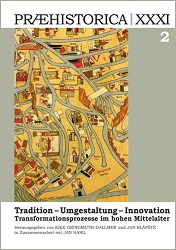Hochmittelalterliche Transformation ländlicher Besiedlungsstrukturen des schlesischen Altsiedellandes im Lichte archäologischer Forschungen
High Medieval Transformation of Rural Settlement Structures in Old Settlement Areas of Lower Silesia According to Archaeological Investigations
Author(s): Krzysztof FoktSubject(s): Archaeology, Social history, Social development, Rural and urban sociology, 6th to 12th Centuries, 13th to 14th Centuries, 15th Century
Published by: Univerzita Karlova v Praze, Nakladatelství Karolinum
Keywords: Middle Ages; Rural Settlement; Lower Silesia;
Summary/Abstract: Main goal of the presented study was to examine processes of transformation of rural settlement structures in the 12th–14th centuries in Lower Silesia, as far as they were reflected in material records documented during archaeological investigations. The analysis has been based upon two groups of settlements: 1. sites dating from the late 12th–13th centuries, where finds typical for local, traditional (“early medieval”) material culture were prevailing, 2. sites dating from the 13th–14th centuries, characterized by preponderance of “late medieval” mobile finds. Both groups of settlements were compared in order to identify: 1. spurs of innovative attempts in the settlements of the 1st group, 2. Archaic features typical only for the 1st group of sites, 3. features that would characterize both groups of settlements, 4. innovative attributes of the 2nd group of rural settlements. Results of the conducted analysis may be summarized as follows: 1. Rural settlements of the 1st group represented a developed stage of the “early medieval” model known from the 11th–12th centuries, showing only few innovations of secondary importance. 2. The fundamental shift of settlement pattern is clearly conceivable through comparison of the settlements of the 1st and the 2nd groups, concerning such features as areas of housing chambers, spatial development of particular farmsteads and rules of spatial organization of village cores. 3. Unexpectedly high was the number of archaic features identified in the 2nd group of settlements (total lack of ovens in houses, presence of sunken housing features). 4. Study of the 2nd group of sites has proven that some elements of the new, “late medieval” patterns of rural economy and settlement (as new manners of waste deposition and spatial rearrangements of settlements) were introduced in the 13th–14th centuries only in some Lower Silesian villages. Presented conclusions are preliminary. To develop more relevant vision of rural transformation in Lower Silesia, more sources and further research would be required, especially studies devoted to the regions newly colonized from the 13th century on and to the rural settlements of the 15th–16th centuries.
Journal: Praehistorica
- Issue Year: 31/2013
- Issue No: 2
- Page Range: 187-198
- Page Count: 12
- Language: German

